三种非谓语动词 间的区别
非谓语动词三大形式
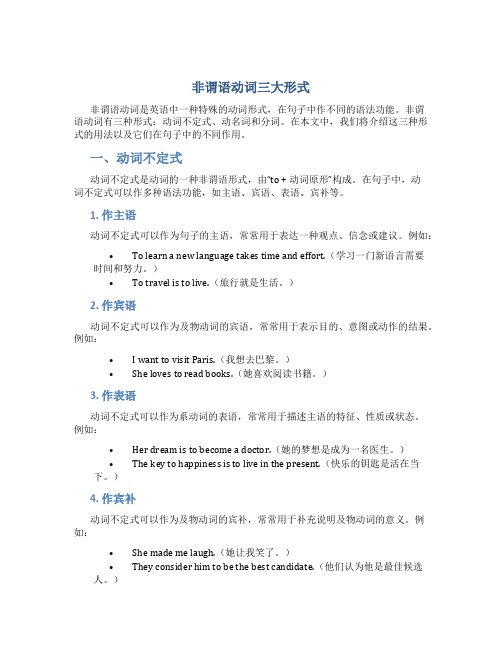
非谓语动词三大形式非谓语动词是英语中一种特殊的动词形式,在句子中作不同的语法功能。
非谓语动词有三种形式:动词不定式、动名词和分词。
在本文中,我们将介绍这三种形式的用法以及它们在句子中的不同作用。
一、动词不定式动词不定式是动词的一种非谓语形式,由“to + 动词原形”构成。
在句子中,动词不定式可以作多种语法功能,如主语、宾语、表语、宾补等。
1. 作主语动词不定式可以作为句子的主语,常常用于表达一种观点、信念或建议。
例如:•To learn a new language takes time and effort.(学习一门新语言需要时间和努力。
)•To travel is to live.(旅行就是生活。
)2. 作宾语动词不定式可以作为及物动词的宾语,常常用于表示目的、意图或动作的结果。
例如:•I want to visit Paris.(我想去巴黎。
)•She loves to read books.(她喜欢阅读书籍。
)3. 作表语动词不定式可以作为系动词的表语,常常用于描述主语的特征、性质或状态。
例如:•Her dream is to become a doctor.(她的梦想是成为一名医生。
)•The key to happiness is to live in the present.(快乐的钥匙是活在当下。
)4. 作宾补动词不定式可以作为及物动词的宾补,常常用于补充说明及物动词的意义。
例如:•She made me laugh.(她让我笑了。
)•They consider him to be the best candidate.(他们认为他是最佳候选人。
)二、动名词动名词是动词的一种非谓语形式,以-ing结尾。
在句子中,动名词可以作多种语法功能,如主语、宾语、表语、宾补等。
1. 作主语动名词可以作为句子的主语,常常用于表示一种习惯、经验或普遍情况。
例如:•Running helps to keep me fit.(跑步有助于保持健康。
非谓语动词的三种形式及用法区别

非谓语动词的三种形式及用法区别一、非谓语动词的三种形式:1. 动词-ing形式:动词-ing形式具有动名词的功能,一般用来表示一个正在进行或发生的动作,以及被动含义,等。
比如:He was observed walking along the street. 他被观察到沿着街道走。
2. 动词不定式形式:动词不定式具有名词、形容词和动词的功能,常用来表示目的、动机、结果、条件、时间、让步等。
比如:To face the danger bravely is his duty. 勇敢的去面对危险是他的责任。
3. 动词的过去分词形式:动词的过去分词常用来表示完成或发生过的动作或状态,以及主句的谓语动词的被动的形式,常用结构有:Be + done/past participle (被动),Have/Get + done(完成).比如:The machine is now ready to be used. 这台机器现在准备好被使用了。
二、非谓语动词的用法区别:1. 动词-ing形式:(1) 用作定语:形容词性短语作定语修饰名词或代词,如:He was aman working hard. 他是个努力工作的人。
(2) 用作表语:Ing 形式的短语作表语,表示一个正在进行的动作或状态,如:His job is repairing the machine. 他的工作是修理机器。
2. 动词不定式形式:(1) 作宾补:动词不定式作宾补表示“目的”,“动机”,“结果”,“条件”,“时间”,“让步”等。
如:He came here to do something for us. 他来这里为我们做一些事情。
(2) 作状语:动词不定式作状语,表示“目的”,“动机”,“条件”,“时间”,“让步”等。
如:She always goes out for a walk to relax herself. 她总是出去散步来放松自己。
高中非谓语的三种形式和用法

高中非谓语的三种形式和用法(一)非谓语动词一、定义非谓语动词(Non-Finite Verbs)是指动词形态上不能用作谓语或表语的各种动词,它不能表示完成形式、时态和语态,它包括动名词、不定式、分词和现在分词。
它们都可以做主语、宾语或补足语。
二、分类(1)动名词动名词(Gerund)是动词词尾加 -ing 构成的名词,它是动词的名词化形式,一般能起主语、宾语及补语的作用,作主语时通常用来表示某种动作被一般进行着。
(2)不定式不定式(Infinitive)是由 to 加上动词原形构成,能作主语、宾语及补足语,表示某种未完成的动作或态度。
(3)分词分词(Participle)是现在分词(Present Participle)和过去分词(Past Participle)的统称,它的形态类似形容词,但可作简单句中的状语,也可作定语、表语和宾语补足语,有时也能作主语。
现在分词(Present Participle)的形式结尾常常是-ing,例如 working,它在现在完成时态中往往作定语,表示时间先后次序。
三、用法动名词可以作主语、宾语和补足语,在简单句中可以作主语,如:Studying other culture is quite interesting. 学习其他文化很有趣。
也可以作宾语,如:I like studying other culture. 我喜欢学习其他文化。
还可以作补足语,如:He was seen studying in the library. 他被看到在图书馆里学习。
不定式可以作宾语、宾语补足语及表语,但不能作状语,它可以用来表示时间、条件、原因、让步等,如:He agreed to help me. 他同意帮助我。
We came here to visitthe museum. 我们来这里参观博物馆。
分词可以用作定语、表语、状语、宾语补足语和宾语,用作定语时表示定语所修饰的名词发生的先后顺序,如:A broken cup was found on the ground. 地上发现了一个破杯子。
非谓语动词的三种形式及用法讲解
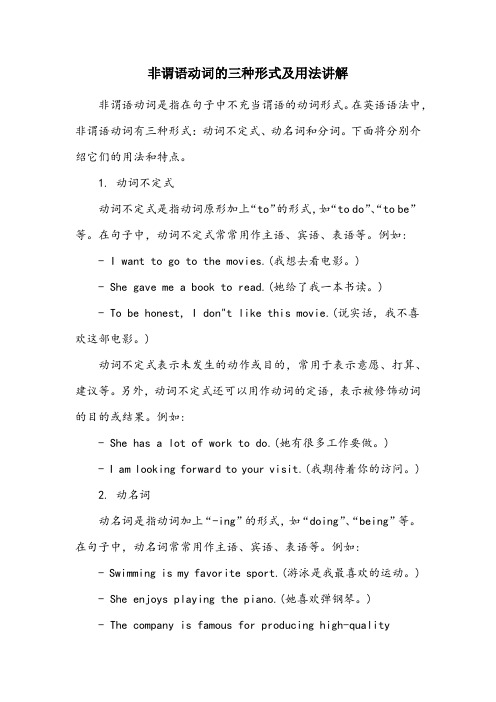
非谓语动词的三种形式及用法讲解非谓语动词是指在句子中不充当谓语的动词形式。
在英语语法中,非谓语动词有三种形式:动词不定式、动名词和分词。
下面将分别介绍它们的用法和特点。
1. 动词不定式动词不定式是指动词原形加上“to”的形式,如“to do”、“to be”等。
在句子中,动词不定式常常用作主语、宾语、表语等。
例如:- I want to go to the movies.(我想去看电影。
)- She gave me a book to read.(她给了我一本书读。
)- To be honest, I don"t like this movie.(说实话,我不喜欢这部电影。
)动词不定式表示未发生的动作或目的,常用于表示意愿、打算、建议等。
另外,动词不定式还可以用作动词的定语,表示被修饰动词的目的或结果。
例如:- She has a lot of work to do.(她有很多工作要做。
)- I am looking forward to your visit.(我期待着你的访问。
)2. 动名词动名词是指动词加上“-ing”的形式,如“doing”、“being”等。
在句子中,动名词常常用作主语、宾语、表语等。
例如:- Swimming is my favorite sport.(游泳是我最喜欢的运动。
) - She enjoys playing the piano.(她喜欢弹钢琴。
)- The company is famous for producing high-qualityproducts.(这家公司以生产高质量的产品而闻名。
)动名词表示正在进行的动作或状态,常用于表示爱好、兴趣、能力等。
另外,动名词还可以用作动词的定语,表示被修饰动词的方式或伴随状况。
例如:- I am feeling very tired.(我感觉很累。
)- She was excited about learning a new language.(她对学习一门新语言感到兴奋。
非谓语动词的三种形式解析

非谓语动词的三种形式解析非谓语动词是指在句子中不担任谓语的动词形式,包括动词不定式、动名词和分词。
它们具有独立的语法作用,并能表达动作、状态或性质。
下面我们来详细解析非谓语动词的三种形式。
一、动词不定式动词不定式是动词的一种形式,通常由“to”加上动词原形构成。
动词不定式可以作为主语、宾语、表语、定语、状语等成分,具有时态和语态等变化。
1. 作主语:To learn a foreign language is beneficial for personal development.学习外语对个人发展有益。
2. 作宾语:The students want to visit the museum this weekend.这些学生想在这个周末参观博物馆。
3. 作表语:Her dream is to become a famous singer.她的梦想是成为一名著名歌手。
4. 作定语:I have a lot of books to read.我有很多书要读。
5. 作状语:He works hard to achieve his goals.他努力工作以实现他的目标。
二、动名词动名词是动词加上-ing构成的名词形式,具有名词的特点,可以担任主语、宾语、定语、表语等成分。
1. 作主语:Swimming is her favorite sport.游泳是她最喜欢的运动。
2. 作宾语:I enjoy playing the piano in my spare time.我喜欢在闲暇时间弹钢琴。
3. 作定语:The running water sounds very soothing.流水的声音听起来很舒缓。
4. 作表语:His hobby is collecting stamps.他的爱好是集邮。
三、分词分词是动词的一种形式,在句中可以作定语、状语等成分,常见的分词形式有现在分词(-ing形式)和过去分词(-ed、-en等形式)。
非谓语动词用法对比

非谓语动词用法对比英语中动词分为两大类:一类是谓语动词,一类是非谓语动词.顾名思义,谓语动词就是在句子中做谓语的动词,即do;而非谓语动词在句子中可以做除了谓语以外的其他任何成分,即doing\to do\done.在句子中充当除谓语以外的各种句子成分的动词形式叫做非谓语动词.非谓语动词有三种:不定式、动名词和分词(现在分词和过去分词).知识要点:一、不定式与动名词做主语:1) 不定式一般表示具体的、特定的行为;而-ing分词一般表示抽象的、一般的行为。
动名词作主语时,它已经将动词名词化了,已把某个动作视为某种活动或事情了,动作意义很弱,比较抽象;而不定式作主语,动作意义强,多指“要去做某事”,这种动作往往是“要发生的一次性动作”,比较具体。
如:To complete the program needs much effort. 完成这项计划需要很大的努力。
Riding a bike can make a man smart. 骑单车能使一个人敏捷。
Smoking is forbiden. 抽烟是禁止的。
To smoke here is not very good. 在这抽烟不太好。
(2) 在疑问句中,只能用动名词的复合结构作主语。
如:Is his speaking reasonable? 她的说话有道理吗?(3) 在某些句型中通常要用动名词短语作主语。
如:It is no use doing…It is no good doing…It is useless doing…It is worthwhile doing…如:It is no use talking your trouble to a man like him. 跟他那样的人谈你的烦恼没有用。
常用不定式做主语的句型有:It’s difficult (important, necessary…) for sb. to do…It’s kind (good, friendly, polite, careless, rude, cruel, clever, foolish, brave…) of sb.to do…(4) 一般说来,作主语和表语的非谓语动词形式应一致,即:或同时为不定式,或同时为-ing 分词。
如何区分三种非谓语动词
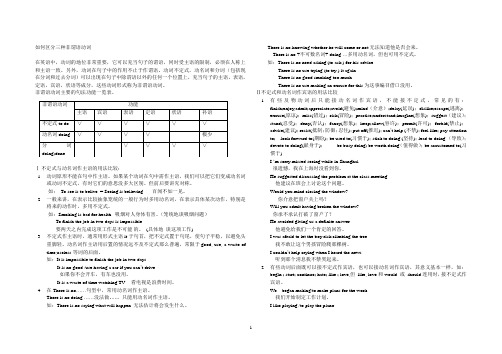
如何区分三种非谓语动词在英语中,动词的地位非常重要,它可以充当句子的谓语,同时受主语的限制,必须在人称上和主语一致。
另外,动词在句子中的作用不止于作谓语。
动词不定式,动名词和分词(包括现在分词和过去分词)可以出现在句子中除谓语以外的任何一个位置上,充当句子的主语,表语,定语,宾语,状语等成分,这些动词形式称为非谓语动词。
非谓语动词主要的句法功能一览表。
Ⅰ.不定式与动名词作主语的用法比较:1.动词原形不能在句中作主语。
如果某个动词在句中需作主语,我们可以把它们变成动名词或动词不定式,有时它们的意思没多大区别。
但前后要讲究对称。
如:To see is to belive. = Seeing is believing. 百闻不如一见。
2.一般来讲,在表示比较抽象笼统的一般行为时多用动名词,在表示具体某次动作,特别是将来的动作时,多用不定式。
如:Smoking is bad for health. 吸烟对人身体有害。
(笼统地谈吸烟问题)To finish the job in two days is impossible.要两天之内完成这项工作是不可能.的。
(具体地谈这项工作)3.不定式作主语时,通常用形式主语it于句首,把不定式置于句尾,使句子平稳,以避免头重脚轻。
动名词作主语用后置的情况远不及不定式那么普遍,常限于good, use, a waste of time,useless等词的后面。
如:It is impossible to finish the job in two days.It is no good /use having a car if you can’t drive.如果你不会开车,有车也没用。
It is a waste of time watching TV. 看电视是浪费时间。
4.在There is no……句型中,常用动名词作主语。
There is no doing ……没法做。
英语非谓语动词讲解
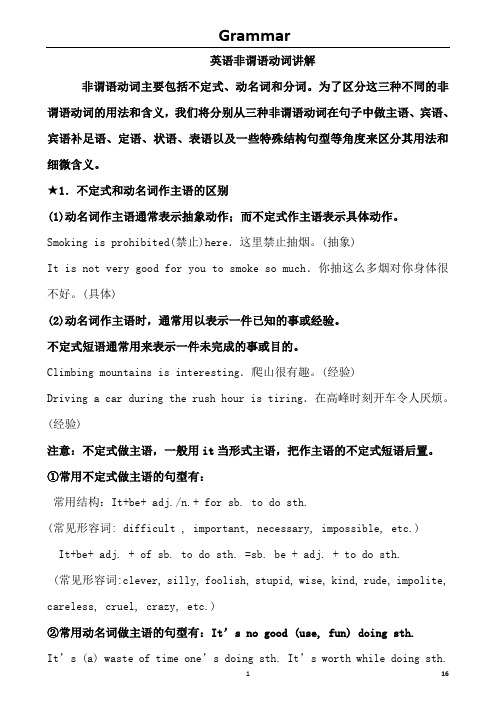
英语非谓语动词讲解非谓语动词主要包括不定式、动名词和分词。
为了区分这三种不同的非谓语动词的用法和含义,我们将分别从三种非谓语动词在句子中做主语、宾语、宾语补足语、定语、状语、表语以及一些特殊结构句型等角度来区分其用法和细微含义。
★1.不定式和动名词作主语的区别(1)动名词作主语通常表示抽象动作;而不定式作主语表示具体动作。
Smoking is prohibited(禁止)here.这里禁止抽烟。
(抽象)It is not very good for you to smoke so much.你抽这么多烟对你身体很不好。
(具体)(2)动名词作主语时,通常用以表示一件已知的事或经验。
不定式短语通常用来表示一件未完成的事或目的。
Climbing mountains is interesting.爬山很有趣。
(经验)Driving a car during the rush hour is tiring.在高峰时刻开车令人厌烦。
(经验)注意:不定式做主语,一般用it当形式主语,把作主语的不定式短语后置。
①常用不定式做主语的句型有:常用结构:It+be+ adj./n.+ for sb. to do sth.(常见形容词: difficult , important, necessary, impossible, etc.)It+be+ adj. + of sb. to do sth. =sb. be + adj. + to do sth.(常见形容词:clever, silly, foolish, stupid, wise, kind, rude, impolite, careless, cruel, crazy, etc.)②常用动名词做主语的句型有:It’s no good (use, fun) doing sth.It’s (a) waste of time one’s doing sth. It’s worth while doing sth.★2.不定式、动名词和分词作表语的区别(1)不定式作表语1)不定式作表语一般表示具体动作,特别是表示将来的动作。
在英语中非谓语动词的用法
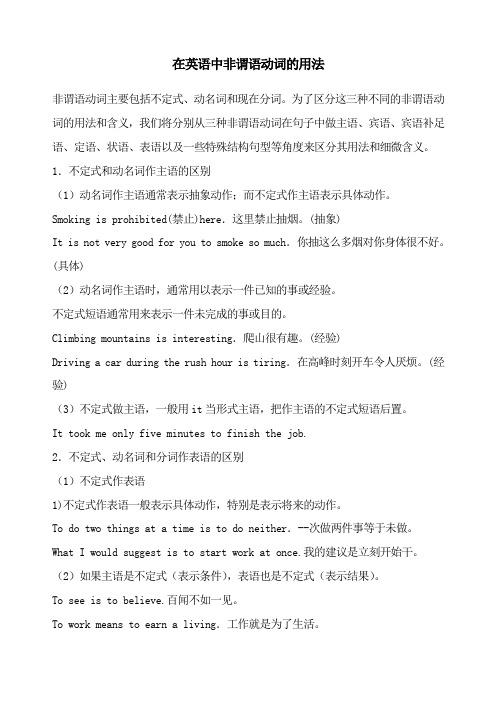
在英语中非谓语动词的用法非谓语动词主要包括不定式、动名词和现在分词。
为了区分这三种不同的非谓语动词的用法和含义,我们将分别从三种非谓语动词在句子中做主语、宾语、宾语补足语、定语、状语、表语以及一些特殊结构句型等角度来区分其用法和细微含义。
1.不定式和动名词作主语的区别(1)动名词作主语通常表示抽象动作;而不定式作主语表示具体动作。
Smoking is prohibited(禁止)here.这里禁止抽烟。
(抽象)It is not very good for you to smoke so much.你抽这么多烟对你身体很不好。
(具体)(2)动名词作主语时,通常用以表示一件已知的事或经验。
不定式短语通常用来表示一件未完成的事或目的。
Climbing mountains is interesting.爬山很有趣。
(经验)Driving a car during the rush hour is tiring.在高峰时刻开车令人厌烦。
(经验)(3)不定式做主语,一般用it当形式主语,把作主语的不定式短语后置。
It took me only five minutes to finish the job.2.不定式、动名词和分词作表语的区别(1)不定式作表语1)不定式作表语一般表示具体动作,特别是表示将来的动作。
To do two things at a time is to do neither.--次做两件事等于未做。
What I would suggest is to start work at once.我的建议是立刻开始干。
(2)如果主语是不定式(表示条件),表语也是不定式(表示结果)。
To see is to believe.百闻不如一见。
To work means to earn a living.工作就是为了生活。
(3)如果主语是以aim, duty, hope, idea, happiness, job, plan, problem,purpose, thing, wish等为中心的名词,或以what引导的名词性从句,不定式作表语是对主语起补充说明作用。
非谓语动词的三种形式

非谓语动词共分为三种,构成形式如下:1.动词不定式(Infinitives):2.现在分词和过去分词(present participles & past participles):3. 动名词(gerunds)下面我们依据句子的成分,来具体分析非谓语动词的不同用法。
1.非谓语动词做主语和表语主语、表语和同位语在句子中用名词来担当,非谓语动词中动词不定式和动名词均可以用作名词,因此,动词不定式和动名词可以用来担当这三种成分。
1)非谓语动词做主语一般情况下,用动名词来做主语的情况比拟多,动词不定式用作主语的情况比拟少。
通常来说,在表达将来的要发生的事情时用不定式来作主语,而表达一般情况习惯性的动作时用动名词来作主语。
例如:Teaching is a tiring but satisfying job.Swimming is a good kind of e*ercise.To be an astronaut is Johnson’s desire.在用it做形式主语的句子中通常用动词不定式来做真正的主语。
例如:It is necessary (for you) to give up smoking.It is everyone’s duty to protect the environment.但是值得注意的是在各别情况下,即使是It做形式主语,真正的主语也必须用动名词,这些情况很少,所以希望同学们能单独记忆下来,以下是此类情况的一个总结。
It is/was no use/good doing sth.It is/was not any use/good doing sth.It is/was of little use/good doing sth.2)非谓语动词做表语非谓语动词作此成分的时候跟作主语时的规则根本一致。
在表示"目的,愿望,梦想,需求〞等名词做主语时其表语应该用不定式.例如:Her wish was to bee an artist.她的愿望是成为一位艺术家Our aim is to help them,not to teach them a lesson.我们的目的是帮助他们,而不是教训他们。
非谓语动词的三种形式与用法

非谓语动词的三种形式与用法非谓语动词是指在句子中充当其他成分而不担任谓语的动词形式。
一般来说,非谓语动词有三种形式:不定式、动名词和分词。
它们在句子中有着不同的用法和功能。
下面将详细介绍这三种非谓语动词的形式与用法。
一、不定式不定式是动词的一种形式,它可以作为名词、形容词或副词的补语,也可以作为谓语的补语。
不定式一般由“to + 动词原形”构成。
1. 作为名词的补语不定式可以作为名词的补语,起到与名词相同的作用。
例如:- My dream is to travel around the world.(我的梦想是环游世界。
)- I have a lot of work to do.(我有很多事情要做。
)2. 作为形容词的补语不定式可以作为形容词的补语,修饰名词或代词。
例如:- She has a book to read.(她有一本要读的书。
)- I am happy to see you.(见到你我很高兴。
)3. 作为副词的补语不定式可以作为副词的补语,修饰动词、形容词或副词。
例如:- He ran fast to catch the bus.(他快速地跑去赶公交车。
)- I woke up early to prepare for the exam.(我早早醒来准备考试。
)二、动名词动名词是一种以-ing 结尾的动词形式,它可以作为名词的主语、宾语、定语、表语等。
1. 作为名词的主语动名词可以作为句子的主语,表示某种行为或概念。
例如:- Swimming is good exercise.(游泳是一项好的锻炼。
)- Reading books is my favorite hobby.(阅读书籍是我最喜欢的爱好。
)2. 作为名词的宾语动名词可以作为某些动词的宾语,表示被动或完成的动作。
例如:- I enjoy swimming in the sea.(我喜欢在海里游泳。
)- She hates doing household chores.(她讨厌做家务活。
非谓语动词的三种形式及用法总结
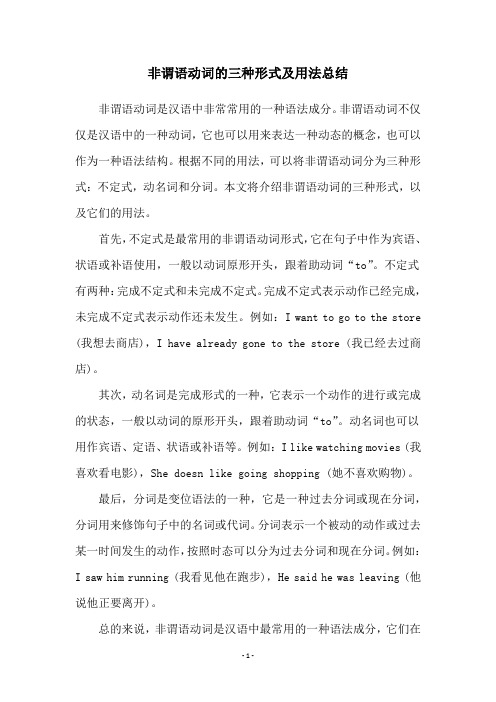
非谓语动词的三种形式及用法总结非谓语动词是汉语中非常常用的一种语法成分。
非谓语动词不仅仅是汉语中的一种动词,它也可以用来表达一种动态的概念,也可以作为一种语法结构。
根据不同的用法,可以将非谓语动词分为三种形式:不定式,动名词和分词。
本文将介绍非谓语动词的三种形式,以及它们的用法。
首先,不定式是最常用的非谓语动词形式,它在句子中作为宾语、状语或补语使用,一般以动词原形开头,跟着助动词“to”。
不定式有两种:完成不定式和未完成不定式。
完成不定式表示动作已经完成,未完成不定式表示动作还未发生。
例如:I want to go to the store (我想去商店),I have already gone to the store (我已经去过商店)。
其次,动名词是完成形式的一种,它表示一个动作的进行或完成的状态,一般以动词的原形开头,跟着助动词“to”。
动名词也可以用作宾语、定语、状语或补语等。
例如:I like watching movies (我喜欢看电影),She doesn like going shopping (她不喜欢购物)。
最后,分词是变位语法的一种,它是一种过去分词或现在分词,分词用来修饰句子中的名词或代词。
分词表示一个被动的动作或过去某一时间发生的动作,按照时态可以分为过去分词和现在分词。
例如:I saw him running (我看见他在跑步),He said he was leaving (他说他正要离开)。
总的来说,非谓语动词是汉语中最常用的一种语法成分,它们在句子中可以用作宾语、状语、补语或定语等,它们的作用是使句子的意义更加完整明确,更加准确地表达说话者的意思。
以上就是有关非谓语动词的三种形式及用法总结,希望能够帮助你更好地使用非谓语动词。
非谓语动词的三种形式
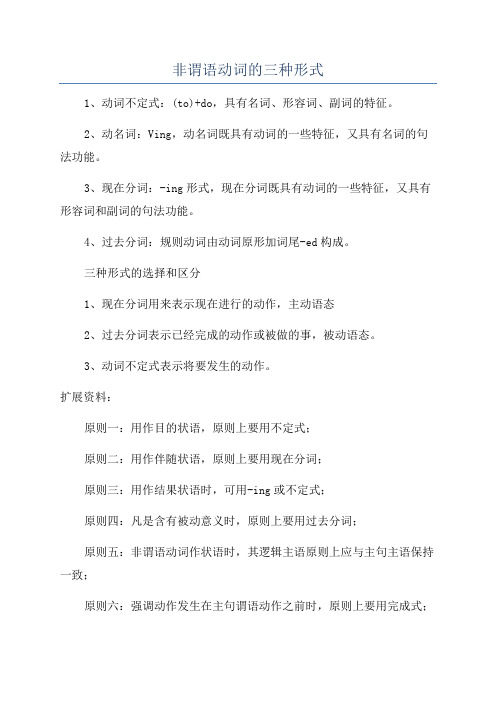
非谓语动词的三种形式
1、动词不定式:(to)+do,具有名词、形容词、副词的特征。
2、动名词:Ving,动名词既具有动词的一些特征,又具有名词的句法功能。
3、现在分词:-ing形式,现在分词既具有动词的一些特征,又具有形容词和副词的句法功能。
4、过去分词:规则动词由动词原形加词尾-ed构成。
三种形式的选择和区分
1、现在分词用来表示现在进行的动作,主动语态
2、过去分词表示已经完成的动作或被做的事,被动语态。
3、动词不定式表示将要发生的动作。
扩展资料:
原则一:用作目的状语,原则上要用不定式;
原则二:用作伴随状语,原则上要用现在分词;
原则三:用作结果状语时,可用-ing或不定式;
原则四:凡是含有被动意义时,原则上要用过去分词;
原则五:非谓语动词作状语时,其逻辑主语原则上应与主句主语保持一致;
原则六:强调动作发生在主句谓语动作之前时,原则上要用完成式;
原则七:用于名词后作定语时,原则是:用不定式,表示动作尚未发生;用-ing,表示动作正在进行;用过去分词,表示动作已经发生,同时表示被动意义。
谓语动词在句中作谓语,受主语的人称和数的限制;非谓语动词在句中不能单独作谓语,它不受主语的人称和数的限制。
英语中不能单独做句子的谓语。
词法:非谓语动词用法区别
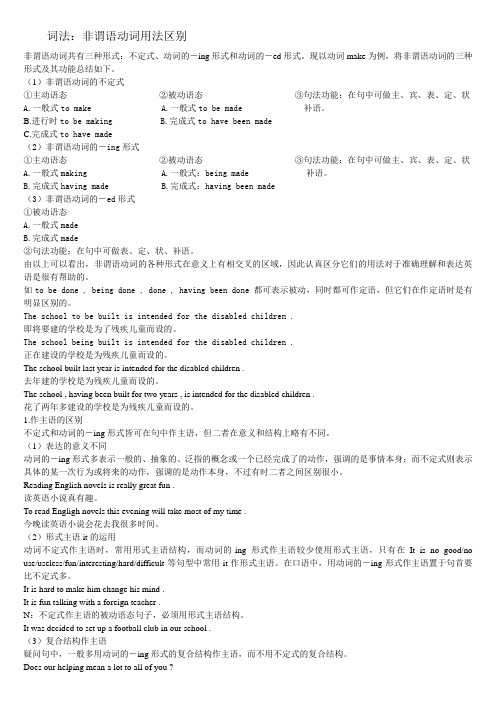
词法:非谓语动词用法区别非谓语动词共有三种形式:不定式、动词的-ing形式和动词的-ed形式。
现以动词make为例,将非谓语动词的三种形式及其功能总结如下。
(1)非谓语动词的不定式①主动语态②被动语态③句法功能:在句中可做主、宾、表、定、状A.一般式to make A.一般式to be made 补语。
B.进行时to be making B.完成式to have been madeC.完成式to have made(2)非谓语动词的-ing形式①主动语态②被动语态③句法功能:在句中可做主、宾、表、定、状A.一般式making A.一般式:being made 补语。
B.完成式having made B.完成式:having been made(3)非谓语动词的-ed形式①被动语态A.一般式madeB.完成式made②句法功能:在句中可做表、定、状、补语。
由以上可以看出,非谓语动词的各种形式在意义上有相交叉的区域,因此认真区分它们的用法对于准确理解和表达英语是很有帮助的。
如to be done , being done , done , having been done 都可表示被动,同时都可作定语,但它们在作定语时是有明显区别的。
The school to be built is intended for the disabled children .即将要建的学校是为了残疾儿童而设的。
The school being built is intended for the disabled children .正在建设的学校是为残疾儿童而设的。
The school built last year is intended for the disabled children .去年建的学校是为残疾儿童而设的。
The school , having been built for two years , is intended for the disabled children .花了两年多建设的学校是为残疾儿童而设的。
非谓语动词的用法及区别

非谓语动词主要包括不定式、动名词和现在分词。
为了区分这三种不同的非谓语动词的用法和含义,我们将分别从三种非谓语动词在句子中做主语、宾语、宾语补足语、定语、状语、表语以及一些特殊结构句型等角度来区分其用法和细微含义。
1.不定式和动名词作主语的区别(1)动名词作主语通常表示抽象动作;而不定式作主语表示具体动作。
Smoking is prohibited(禁止)here.这里禁止抽烟。
(抽象)It is not very good for you to smoke so much.你抽这么多烟对你身体很不好。
(具体)(2)动名词作主语时,通常用以表示一件已知的事或经验。
不定式短语通常用来表示一件未完成的事或目的。
Climbing mountains is interesting.爬山很有趣。
(经验)Driving a car during the rush hour is tiring.在高峰时刻开车令人厌烦。
(经验)(3)不定式做主语,一般用it当形式主语,把作主语的不定式短语后置。
It took me only five minutes to finish the job.2.不定式、动名词和分词作表语的区别(1)不定式作表语1)不定式作表语一般表示具体动作,特别是表示将来的动作。
To do two things at a time is to do neither.--次做两件事等于未做。
What I would suggest is to start work at once.我的建议是立刻开始干。
2)如果主语是不定式(表示条件),表语也是不定式(表示结果)。
To see is to believe.百闻不如一见。
To work means to earn a living.工作就是为了生活。
3)如果主语是以aim,duty,hope,idea,happiness,job,plan,problem,purpose,thing,wish等为中心的名词,或以what引导的名词性从句,不定式作表语是对主语起补充说明作用。
非谓语三种形式的区别和辨析

非谓语动词三种形式用法的区别:1. 做主语:v-ing & to do 都可以做主语,大多数情况两者没有区别。
注意:但是v-ed不可以做主语。
Exploring the Amazon River deserves courage. ( doing 表抽象的概念)To explore the Amazon River deserves courage. ( to do 表具体的/将来的动作)其余注意事项:1)Seeing is believing.To see is to believe. (即:主语与表语的形式要一致)但是不能说:Seeing is to believe; 或者To see is believing.2)Lincoln said it was not right for the south to break away from the union.Linda said it was nice of you to lend her money.The children’s loving nature can surely inspire their love for their family members.3) It is no good / no use / useless + doing sth 句型It’s no use crying over spilt milk.4) There is no + doing. 句型There is no knowing what will happen next. 谁也不知道下一步会发生什么。
There is no telling what will happen. 谁也无法判断、辨别将要发生什么。
2. 做表语:My favorite hobby is to collect / collecting old coins. (一般概念to do/doing 可以互换)Our aim is to help the old lead a happy life. (表具体的/将来的动作用to do)We were all greatly amazed at the children’s wonderful performance.The children’s wonderful performance was amazing.3. 作宾语:用哪种形式做宾语往往跟动词的搭配用法有关like / love to do & like / love doing;begin / start to do & begin / start doing;prefer to do & prefer doing;continue to do & continue doing;try to do VS try doing;mean to do VS mean doing;can’t help doing VS can’t help (to) dogo on to do VS go on doing;stop to do VS stop doing;forget to do VS forget doing / forget having doneregret to do VS regret doing / regret having done;remember to do VS remember doing / remember having done;sth need doing & sth need to be done (需要)sth require doing & sth require to be done (需要)sth want doing & sth want to be done (需要)sth deserve doing & sth deserve to be done (值得)需要注意的重要形式:特殊疑问词(how / what / when/ where…) + to do = 宾语从句Hearing the sad news, I didn’t know what to do.= Hearing the sad news, I didn’t know what I could do.I couldn’t decide whether to work another year or change my job.= I couldn’t decide whether I could work another year or change my job.2)it 做形式宾语,to do / doing做真正的宾语I though it an honor to have been invited to dinner. ( to be invited to dinner的完成式) I found it no use attempting to lose weight by going on diet.3)I’m looking forward to seeing you again.I have no choice but to stay home for another hour.I have nothing to do but stay home for another hour.I can do nothing but stay home for another hour.4. 作宾语补足语:(考试重点)I often notice a little boy pass this corridor and enter the garden.I found a stranger walking nearby our shop.( doing 强调动作正在进行;(看到、注意到)动作的一部分)( to do强调动作已经完成;(看到、注意到)动作的全过程请注意下列句子的区别:We heard her singing next door. (听到她唱歌动作的一部分;听到她正在唱歌) (主动正在进行)We heard her sing next door. (听到她唱歌动作的全部分;听到她唱过歌) (主动完成)We heard the song sung by her. (听到这首歌被她唱过) (被动完成)We heard the song being sung by her next door. (听到她这首歌正在被她唱)(被动正在进行)Don’t have the water running all the day. (让…一直做) (主动,一直进行)The teacher had him read the text three times. (让...做…)(主动,做具体一件事情)I had my hair colored last Friday. (让…由别人做;遭遇到不好的事情)(被动,有别人完成)注意跟I have a lot of homework to do today. (有) 的区别。
非谓语三种形式

非谓语三种形式
非谓语动词,又称非谓词、非谓宾,可以分为三种形式:动名词、不定式和分词。
一、动名词
动名词往往用作名词,可发挥名词的各种用法,常构成名词词组,充当各种句子成分,如主语、宾语、定语等,例如:
The manager is holding a meeting tomorrow(明天经理要召开
会议)。
Eating vegetables is healthy for us(吃蔬菜对我们健康)。
二、不定式
不定式通常用作动词,发挥动词的各种用法,如实义动词、系动
词等,也可以构成各种句子成分,如宾语、宾补等,例如:We plan to finish the work today(我们准备今天完工)。
I am determined to help our school out of the trouble(我
决心帮助学校摆脱困境)。
三、分词
分词主要用作形容词,发挥形容词的各种用法,常构成形容词词组,也可以构成各种句子成分,如定语、状语等,例如:
I saw a child crying in the corner(我看到一个孩子在角落
里哭着)。
His house was destroyed by the flood(他的房子被洪水摧毁了)。
以上论述显示出,非谓语动词不仅可以构成各种句子成分,而且
各自也发挥着不同的用法。
总之,非谓语动词是语言的重要组成部分,在表达方面各具特色,无论是英语还是其它语言中都非常重要,它们
的运用能够使句子更明晰、更流畅,使听者或读者能够理解发言者的
意思。
三种非谓语的区别
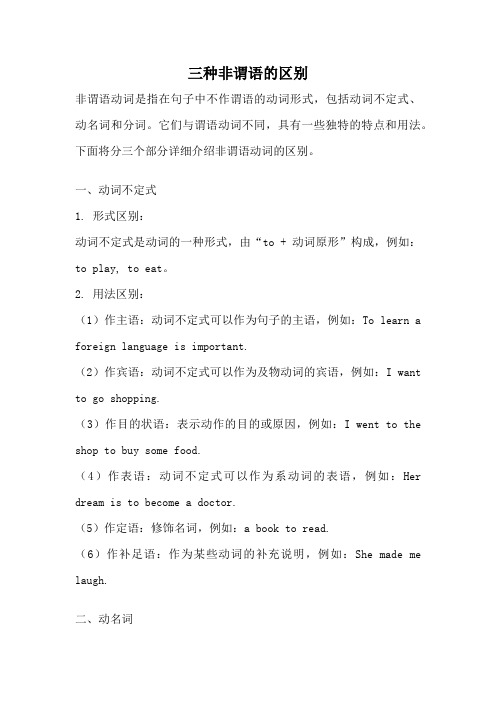
三种非谓语的区别非谓语动词是指在句子中不作谓语的动词形式,包括动词不定式、动名词和分词。
它们与谓语动词不同,具有一些独特的特点和用法。
下面将分三个部分详细介绍非谓语动词的区别。
一、动词不定式1. 形式区别:动词不定式是动词的一种形式,由“to + 动词原形”构成,例如:to play, to eat。
2. 用法区别:(1)作主语:动词不定式可以作为句子的主语,例如:To learn a foreign language is important.(2)作宾语:动词不定式可以作为及物动词的宾语,例如:I want to go shopping.(3)作目的状语:表示动作的目的或原因,例如:I went to the shop to buy some food.(4)作表语:动词不定式可以作为系动词的表语,例如:Her dream is to become a doctor.(5)作定语:修饰名词,例如:a book to read.(6)作补足语:作为某些动词的补充说明,例如:She made me laugh.二、动名词1. 形式区别:动名词是动词的一种形式,以-ing结尾,例如:playing, eating。
2. 用法区别:(1)作主语:动名词可以作为句子的主语,例如:Swimming is good for health.(2)作宾语:动名词可以作为及物动词的宾语,例如:I enjoy swimming.(3)作目的状语:表示动作的目的或原因,例如:I went swimming to relax.(4)作定语:修饰名词,例如:a running dog.(5)作表语:动名词可以作为系动词的表语,例如:His hobby is playing basketball.(6)作宾语补足语:作为某些动词的补充说明,例如:She saw him dancing.三、分词1. 形式区别:分词是动词的一种形式,分为现在分词和过去分词两种形式,例如:playing, eaten。
动词的非谓语形式

动词的非谓语形式动词的非谓语形式有三种,即动词不定式,分词(现在分词和过去分词),动名词。
概说我们根据已经学过的语法知识知道,英语中动词有以下几类:助动词,情态动词,连系动词,行为动词(实义动词)。
助动词本身没有词义,不能单独使用,只能起到语法意义上的作用。
情态动词意思不完整,也不能单独使用,必须要和行为动词一起才能构成完整的意思,在句中作谓语。
连系动词作谓语时,后面接形容词和名词等作表语。
行为动词或实义动词在句中常作谓语,根据其后面能否直接带宾语,行为动词又可分为及物动词和不及物动词。
及物动词后面跟名词,代词或相当于名词的词作宾语,不及物动词必须要和一定的介词一起使用才能带宾语。
由上我们可以看出,行为动词在句中常常用做谓语,受主语的人称和数的限制。
但是,动词及其变化形式在句中也可以不作谓语来使用。
据此,我们又可将动词分为限定动词( finite verb )和非限定动词( non-finite verb )两类。
限定动词在句中作谓语,受主语的人称和数的限制,非限定动词在句中不可单独作谓语,不受主语的人称和数的限制,它在句中可以用作其他句子成分。
非限定动词有三种表现形式,既动词不定式,分词和动名词。
我们通常把这三种形式称之为动词的非谓语形式。
动词的非谓语形式或非限定动词在语法意义上具有双重性质:既具有动词性质,又具有非动词性质。
其动词性质表现在(1)有时式和语态的变化(2)可被状语修饰(3)及物动词须有宾语。
其非动词性质表现在(1)相当于名词(2)相当于形容词。
动词的三种非谓语形式与自己的宾语或状语连用就构成非限定动词短语,分别叫做动词不定式短语,分词短语和动名词短语。
动词不定式和动词不定式短语动词不定式在句中可作主语,主语补足语,宾语,宾语补足语,表语,定语,状语等。
动词不定式也有时式和语态的变化。
1.动词不定式作主语(a)To see is to believe.(b)To master a foreign language is of great importance today.(c)To teach is to learn.(d)It is a great honor to talk with you.2.动词不定式作主语补足语(a) He was seen to enter the hall.(b) It is reported to be true.(c)He is said to be from New York.(d)The young man was considered to have great promise.3.动词不定式作宾语(a) He seemed to know the secret.(b) I want to talk with him very much.(c) He liked to live there, However, he found it difficult to get used to the climate.4.动词不定式作宾语补足语(a)He begged me to give him a hand.(b)I would like you to have an opportunity to appreciate Chinese art.(c) I’ll leave you to attend the matter..(d) The boss made these workers work over 12 hours a day.5. 动词不定式作表语(a ) The duties of a postman are to deliver letters and newspapers.(b) My chief purpose has been to point out the difficulties of the matter.(c ) The important thing is to save lives.(d) The only thing I could do was to leave.(e) His wish is to become a doctor.6.动词不定式作定语(a)The next train to arrive was from Beijing.(b)He was always the first to come and the last to leave the office.(c)The four abilities to learn a language are listening, speaking, reading and writing.(d) Our need to communicate with each other has been a driving force in the developmentof technology.7.动词不定式作状语(a)He cupped his ears to hear better.(b)I stayed there to see what would happen.(c ) I come here to see you.(d) To emphasise the woman even more, Chen Yifei adds a lot of detail to the fan and thecloth of her dress.(e)Between 1933and 1940, Xu Beihong held several exhibitions in Asia and Europe topromote Chinese art.上述动词不定式或动词不定式短语在句中作目的状语。
- 1、下载文档前请自行甄别文档内容的完整性,平台不提供额外的编辑、内容补充、找答案等附加服务。
- 2、"仅部分预览"的文档,不可在线预览部分如存在完整性等问题,可反馈申请退款(可完整预览的文档不适用该条件!)。
- 3、如文档侵犯您的权益,请联系客服反馈,我们会尽快为您处理(人工客服工作时间:9:00-18:30)。
高中三种非谓语动词间的区别注意:当由现在分词和过去分词变化而来的形容词和定冠词连用表示一类人和事时,可用作主语和宾语,如:the dying垂死的人,the wounded 伤员等等。
一,不定式和动名词作主语时的区别。
1,表示一次性的动词多用不定式,表示一般性、经常性的动作多用动名词。
例, is a good form of exercise for both young and old.A The walkB WalkingC To WalkD Walk2, 不定式作主语常用it 作起其形式主语,动名词作主语时常位于句首。
只有某些习惯用语如no use, no good 作表语用时,才用it 作其形式主语。
例 felt funny watching myself on TV.A OneB ThisC ItD That3, 句子主语若是不定式,主语也用不定式;句子表语若是动名词,主语也用动名词。
例 To see is to believe. Seeing is believing. 眼见为实有时这种结构也用于其他情况例,Friendship is like money: easier made than .A keptB to be keptC keepingD being kept二,不定式、动名词和分词作表语时的区别。
1,不定式,动名词作表语具有名词性质,说明主语的内容。
主语是名词时,表示一次性的动作,表语多用不定式;表示一般性、经常性的动作,表语多用动名词。
例 My job today is to water the flowers in the garden.动词不定式作表语表示一次性的动作。
2,分词作表语具有形容词性质和特征。
若主语与分词之间在逻辑上存在主动关系,用现在分词;若主语与分词之间在逻辑上存在被动关系,用过去分词。
This computer game was interesting and the children were interested in it.三,动词不定式与动名词作宾语时的区别。
1,在begin, start, continue, attempt企图,prefer愿意等动词后,用动名词和事不定式区别不大。
例The teacher said,” Y ou begin writing now,” and the children began to write.例 I prefer going/to go there this evening.2, 在 like, love, hate等动词后用不定式作宾语常表示一次性动作,用动名词作常表示一次性动作例,He likes swimming, but he doesn’t like to swim today, because it is too cold.3, 在remember, forget, regret, mean, stop, try, go on, mean等动词后用动词不定式或动名词句意不同。
例 Do you mean to go without money?Try to do sth: 尽力地,努力地要干某事; try doing sth: 试着做某事4,有些及物动词后只能跟动词不定式作宾语,有些只能跟动名词做宾语。
四,动词不定式和作宾语补足语时的区别。
1,宾语与宾语补足语之间存在逻辑上的被动关系时,用过去分词作宾语补足语。
例,The manager discussed the plan that they would like to see the next year.A.carry out B carrying out C carried out D tocarry out经理们讨论了他们想看到在下一年里得到实施的这个计划。
Carriedout 是过去分词短语作宾补,和see的宾语the plan(现在用关系代词that代替,位于从句首 )之间为被动关系。
2,ask, want, beg, order, warn, remind, teach, urge, encourage, persuade, advise, invite, allow, permit, forbid, cause 等一般接带to 不定式作宾补。
例, Alice trust you; only you can persuade her to give up the foolish idea.3, would love/like, prefer, want 等表示情感状态的动词,一般接带to的不定式作宾补。
例,I’d love them come today.例,I don’t want there to be any trouble.4, catch, set, send可接现在分词作宾补。
例,Don’t let me catch you sleeping in the office.例 This set me thinking. 这使我深思。
5,keep, find 可跟现在分词、过去分词两种形式做宾补。
例,I’m sorry to hav e kept you waiting.例 Can you keep the whole matter unknown?6, let, have, make, get, leave等表示致使意义的动词可跟不定式(let make have不带to)现在分词,过去分词三种形式作宾补。
例 His behavior leaves much to be desired. 他的行为令人不满。
例It’s not socially acceptable for parents to leave child ren unattended at that age.例It’s wrong of you to leave the machine running.你让机器一直开着是不对的。
7, see, hear, feel, watch, notice, observe等可跟不带to的不定式、现在分词过去分词三种形式作宾补。
例 Did you notice him pause?例 Did you notice his hands shaking?例 Did you notice anything moved?总结:感官动词后。
用不定式表示动作全过程,用现在分词表示动作正在进行中。
例 The missing boys were last seen near the river.A playingB to be playingC playD to play 五,动词不定式、动名词和分词作定语时的区别。
1,动词不定式作定语多表示将来的动作。
例 I have a lot of work to do today.2, 现在分词作定语表示正在进行的动作,且被修饰词是其逻辑上的动作的执行者。
例 Who is the young man standing over there?3, 过去分词作定语表示发生在过去或没有一定的时间性的动作,且被修饰词是其在逻辑上的动作的承受着。
例 Two hundred stolen bicycles were returned to their owners last month.总结:动词不定式:未来的动作现在分词:正在进行过去分词:发生在过去或无一定的时间性注意:有些动词过去分词和现在分词的形式比较固定:lose 常用过去分词;而miss常用现在分词missing; remain 常用现在分词remaining; leave 常用过去分词left.例 The missing boy has been found. The missing boy 相当于the lost boy例The lady said she would buy a gift for her daughter with the .A.20 dollars remainedB.20 dollars to remainC.remained 20 dollarsD.remaining 20 dollarsremain 常用现在分词作前置定语,表示剩下的相当于20 dollars left. 4, 动词不定式与分词作状语时的区别1,不定式作状语可以表示目的、结果或程度。
例 Tom came to borrow a dictionary from me. We are too young to join the army.2, 分词作状语多表示时间、条件、原因、方式或伴随。
5,不定式的逻辑主语一般由for或of介词短语构成,分词的逻辑主语由主格代词或名词后成,而动名词的逻辑主语或名词后成,而动名词的逻辑主语由形容词性物主代词或宾格代词或名词的所有格(或名词的普通格)来构成。
例 It is important for us to learn English.例 It is nice of you to come and help me例 She being away, her classmates had to do cleaning for her.例 He was forced into the room, his hands tied behind.例 There being no pen, I had to write the letter with a pencil.例 Would you mind me/my opening the window?例Mary’s being late delayed our meeting.。
